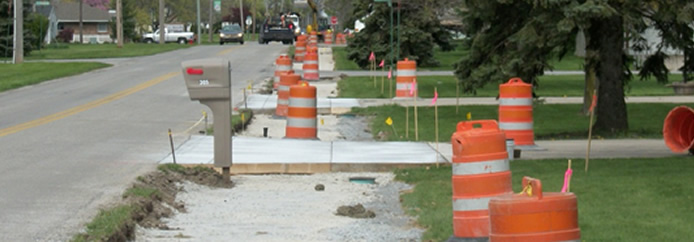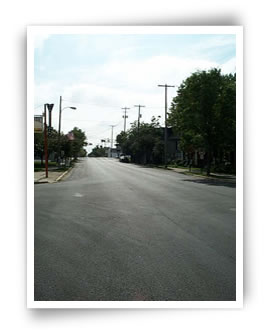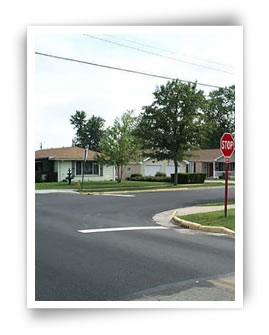


Streets
Current ProjectsWest Main St. Repaved |
Future Projects
|
Roads and the Environment

Roads have significant impacts on both nearby communities and the natural environment. People and properties may be in the direct path of road works and affected in a major way. People may also be indirectly affected by construction, through the disruption of livelihood, loss of accustomed travel paths and community linkages, increases in noise and pollution, and more road accidents.
Disturbances to the natural environment may include soil erosion, changes to streams and underground water, and interference with animal and plant life. New roads may bring development to previously underdeveloped areas, sometimes causing significant effects on sensitive environments and the lifestyles of indigenous people.
The construction process has particular environmental impacts and mitigation options at each level of work: site establishment and setup; construction work activities; and, site restoration after the completion of work. During site establishment it is the location of work facilities and resources that is the key environmental issue.
During construction, on the other hand, erosion is a major risk and can be prevented by prompt planting and control of runoff water. Traffic, noise, waster disposal, and work practices are other important factors which need to be managed by road contractors.
Restoration of work areas, especially quarries, borrow pits, work depots, and material storage sites, is an important aspect of contractor responsibility. Provision is also often required for follow up maintenance of restored vegetation.
Maintenance

Like all structures, roads deteriorate over time. Deterioration is primarily due to accumulated damage from vehicles, however environmental effects such as frost heaves, thermal cracking and oxidation often contribute. Potholes on roads are caused by rain damage and vehicle braking or related construction works.
Roadways are designed and built for primary use by vehicular and pedestrian traffic. Storm drainage and environmental considerations are a major concern. Erosion and sediment controls are constructed to prevent detrimental effects. Drainage lines are laid with sealed joints in the road easement with runoff coefficients and characteristics adequate for the land zoning and storm water system.
Virtually all roads require some form of maintenance before they come to the end of their service life. Pro-active agencies continually monitor road conditions and apply preventive maintenance treatments as needed to prolong the lifespan of their roads.
Technically advanced agencies monitior the road network surface condition with sophisticated equipment such as laser/inertial Profilometers. These measurements include road curvature, cross slope, unevenness, roughness, rutting and texture (roads). This data is fed into a pavement management system, which recommends the best maintenance or construction treatment to correct the damage that has occurred.
Maintenance treatments for asphalt concrete generally include crack sealing, surface rejuvenating, fog sealing, micro-milling and surface treatments. Thin surfacing preserves, protects and improves the functional condition of the road while reducing the need for routing maintenance, leading to extended service life without increasing structural capacity.
Failure to maintain roads properly can create significant costs to society, in a 2009 report released by the American Association of State Highway and Transportation Officials (USA) about 50% of the roads in the USA are in bad condition with urban areas worse. The report estimates that urban drivers pay an average of $746/year on vehicle repairs while the average US motorist pays about $335/year. In contrast, the average motorist pays about $171/year in road maintenance taxes (based on 600 gallons/year and $0.285/gallon tax).

Old road surfaces, fences, and buildings may need to be removed before construction can begin. Trees in the road construction area may be marked for retention. These protected trees should not have the topsoil within the area of the tree's drip line removed and the area should be kept clear of construction material and equipment. Compensation or replacement may be required if a protected tree is damaged. Much of the vegetation may be mulched and put aside for use during reinstatement. The topsoil is usually stripped and stockpiled nearby for rehabilitation of newly constructed embankments along the road. Stumps and roots are removed and holes filled as required before the earthwork begins. Final rehabilitation after road construction is completed will include seeding, planting, watering and other activities to reinstate the area to be consistent with the untouched surrounding areas.
The completed road way is finished by paving or left with a gravel or other natural surface. The type of road surface is dependent on economic factors and expected usage. Safety improvements like Traffic signs, Crash barriers, Raised pavement markers, and other forms of Road surface marking are installed.

